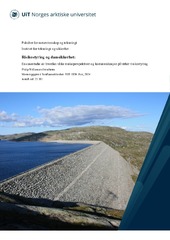Fakultet for naturvitenskap og teknologi: Recent submissions
Now showing items 101-120 of 5444
-
Automating the TinyML Pipeline: From Model Compression to Edge Deployment
(Master thesis, 2025)Deploying machine learning on resource-constrained devices such as microcontrollers, especially in harsh environments (e.g., the arctic) presents significant challenges. This thesis explores solving these challenges in the framework of TinyMLOps, focusing on enabling live model updates and predicting inference latency on STM micro controllers. A method for seamless runtime weight updates via direct ... -
Transfer learning between Sentinel-1 acquisition modes enhances the few-shot segmentation of natural oil slicks in the Arctic
(Journal article; Tidsskriftartikkel; Peer reviewed, 2025-06-12)Natural seepage is a significant contributor to marine hydrocarbon inputs. Remote and intermittent seeps are difficult to monitor in the field, yet surface oil slicks can be observed by spaceborne synthetic aperture radar (SAR) because they reduce backscatter, creating potential for automatic mapping. In mapping tasks like segmentation, deep learning models excel, albeit needing large amounts of ... -
Leveraging Foundation Model Adapters to Enable Robust and Semantic Underwater Exploration
(Chapter; Bokkapittel, 2025-06-17)This position paper presents a framework for intelligent underwater exploration by marrying foundation models (FMs) with multi‑frequency echosounder data. Echosounder data capture backscattered acoustic signals across a range of frequencies, providing rich insights into underwater environments by exploiting the frequency‑dependent scattering properties of underwater targets. However, their heterogeneity ... -
Little to lose: The case for a robust European green hydrogen strategy
(Journal article; Tidsskriftartikkel; Peer reviewed, 2025-06-11)Europe is bound by the Paris Agreement to transition to net-zero greenhouse gas emissions by 2050; the EU has further proposed a 90% emissions reduction target already for 2040. Green hydrogen (that is, hydrogen produced from clean electricity) is often framed as a key component in the transition to net-zero emissions, being a viable emissions-free alternative to fossil fuels in some contexts. ... -
Heavy potassium isotopes in carbonatites reveal oceanic crust subduction as the driver of deep carbon cycling
(Journal article; Tidsskriftartikkel; Peer reviewed, 2025-06-13)Carbon cycling between surface and mantle reservoirs is pivotal in fostering habitability of Earth. A critical yet poorly constrained parameter is whether crustal carbon can “survive” devolatilization processes that accompany slab subduction and therefore influence deep carbon budgets. Carbonatites provide a key record to address this important topic. Here, we present high-precision potassium isotope ... -
Saturation in Forcing Efficiency and Temperature Response of Large Volcanic Eruptions
(Journal article; Tidsskriftartikkel; Peer reviewed, 2025-04-29)Volcanic eruptions cause climate cooling due to the reflection of solar radiation by emitted and subsequently produced aerosols. The climate effect of an eruption may last for about a decade and is nonlinearly tied to the amount of injected SO<sub>2</sub> from the eruption. We investigate the climatic effects of volcanic eruptions, ranging from Mt. Pinatubo-sized events to supereruptions. The study ... -
Nonparametric Estimation of Temperature Response to Volcanic Forcing
(Journal article; Tidsskriftartikkel; Peer reviewed, 2025-05-13)Large volcanic eruptions strongly influence the internal variability of the climate system. Reliable estimates of the volcanic eruption response as simulated by climate models are needed to reconstruct past climate variability. Yet, the ability of models to represent the response to both single-eruption events and a combination of eruptions remains uncertain. We use the Community Earth System Model ... -
Sigmatropic rearrangement enables access to a highly stable spirocyclic nitroxide for protein spin labelling
(Journal article; Tidsskriftartikkel; Peer reviewed, 2025-05-27)Spin labelling enables the study of biomolecules using electron paramagnetic resonance (EPR) spectroscopy. Here, we describe the synthesis of a cysteine-reactive spin label based on a spirocyclic pyrrolidinyl nitroxide containing an iodoacetamide moiety. The spin label was shown to be highly persistent under reducing conditions while maintaining excellent EPR relaxation parameters up to a temperature ... -
Geology of critical mineral deposits of the Kuljuktau Mts., Central Kyzylkum (Uzbekistan)
(Journal article; Tidsskriftartikkel; Peer reviewed, 2024-12-19)This article presents characteristics of geological and tectonic structures of the Kuljuktau Mountains, mineralogical and geochemical features of its volcanic and intrusive rocks and associated mineralisation of critical elements. The Taskazgan graphite, Shaidaraz lithium, and Tozbulak high-purity quartz deposits, and new prospects for rare earth mineralisation have been identified as the most ... -
Planktic calcifiers: from living assemblages to proxies in the Arctic Ocean
(Conference object; Konferansebidrag, 2025)Planktic foraminifers, pteropods, and coccolithophores are marine calcifiers, organisms living in the water column and found throughout all oceans, with shells made of calcium carbonate. Because of their shell, they play an important role in the carbon cycle exporting calcium carbonate from the upper ocean to the sea floor when they die and sink. If no dissolution occurs on the water column or within ... -
Sedimentary ancient DNA insights into foraminiferal diversity near the grounding line in the western Ross Sea, Antarctica
(Journal article; Tidsskriftartikkel; Peer reviewed, 2025-06-06)Foraminifera are important marine environmental indicators widely used in paleoceanography and paleoclimate studies. They are a dominant component of meiobenthic communities around the Antarctic continental shelf, including rarely studied locations below the ice shelves, close to the grounding line. In this study, we use high-throughput sequencing of sedimentary ancient DNA (sedaDNA) targeting ... -
Risikostyring og damsikkerhet: En casestudie av hvordan ulike risikoperspektiver og kommunikasjon påvirker risikostyring
(Master thesis; Mastergradsoppgave, 2024-06-02)Denne masteroppgaven undersøker hvordan risikoperspektiver som finnes i damsikkerheten, hvordan risikostyring fungerer i damsikkerheten, og hvordan kommunikasjon kan brukes som en prosess for å formidle de ulike risikoperspektivene, og legge til rette for en god risikostyring. Tidligere forskning viser til at store dammer er en sektor som burde utformes av risikostyring, men at det ikke ser ut til ... -
Unge arbeidstakere i bygg- og anleggsbransjen: En casestudie av sikkerhetskultur
(Master thesis; Mastergradsoppgave, 2024-06-02)Bygg- og anleggsbransjen er en av de mest ulykkesutsatte næringene i det norske arbeidslivet, og i statistikken er det en betydelig overhyppighet av skader i de yngste aldersgruppene. Denne studien forsker på hvordan organisasjoner i bygg- og anleggsbransjen kan bygge en sikkerhetskultur der unge arbeidstakere sin risiko for arbeidsskader- og ulykker reduseres. Sikkerhetskultur kan beskrives som en ... -
Conformal structures with G2-symmetric twistor distribution
(Journal article; Tidsskriftartikkel; Peer reviewed, 2025-04-03)For any 4D split-signature conformal structure, there is an induced twistor distribution on the 5D space of all self-dual totally null 2-planes, which is (2, 3, 5) when the conformal structure is not anti-self-dual. Several examples where the twistor distribution achieves maximal symmetry (the split-real form of the exceptional simple Lie algebra of type G<sub>2</sub>) were previously known, and ... -
Origin and composition of hydrothermally-influenced sediments at Aurora Vent Field, southwestern Gakkel Ridge (82.9°N)
(Journal article; Tidsskriftartikkel, 2025-05-21)Slow–ultraslow spreading ridges represent half of the total length of the global mid-ocean ridge system and have been recognized to host hydrothermal activity. Their role as a source versus sink of elements in the oceans remains poorly constrained. Here, we present the first sediment data from the Aurora Vent Field (~3900 m depth) on the ultraslow spreading Gakkel mid-ocean ridge and the northernmost ... -
Explainability of deep-learning-derived input function in dynamic PET imaging
(Master thesis; Mastergradsoppgave, 2023-06-01)Dynamic positron emission tomography (PET) imaging is a valuable tool in medical research and practice. By measuring the distribution of a radioactive tracer within the body over time, dynamic PET imaging allows the visualization of various physiological and biological processes. Furthermore, it allows for quantification of such processes using tracer kinetic modeling. However, kinetic modeling ... -
On the Future of Arctic Sea Ice - Projections, Dynamics, and Human Impacts
(Doctoral thesis; Doktorgradsavhandling, 2025-06-20)<p>Arctic sea ice (ASI) is a critical component of the Earth’s climate system, serving as both a regulator of energy exchange and a sensitive indicator of climate change. Over recent decades, ASI has experienced a dramatic decline in both extent and thickness, driven by rising global temperatures and amplified by Arctic feedback mechanisms. This decline is a key driver of Arctic amplification, a ... -
Symmetries of (2, 3, 5)-distributions and associated Legendrian cone structures
(Journal article; Tidsskriftartikkel; Peer reviewed, 2025-04-30)We exploit a natural correspondence between holomorphic (2, 3, 5)-distributions and nondegenerate lines on holomorphic contact manifolds of dimension 5 to present a new perspective in the study of symmetries of (2, 3, 5)-distributions. This leads to a number of new results in this classical subject, including an unexpected relation between the multiply-transitive families of models having 7- and ... -
Device-based measurement of lifestyle-related variables from the hip
(Doctoral thesis; Doktorgradsavhandling, 2025-06-17)Physical activity epidemiology is the study of patterns, risks, and effects of physical activity within populations. It plays a crucial role in understanding how physical activity influences health outcomes, such as reducing the risk of chronic diseases like cardiovascular disease, diabetes, and obesity. An important prerequisite is the accurate measurement of physical activity, which can be assessed ... -
Automatic time in bed detection from hip-worn accelerometers for large epidemiological studies: The Tromsø Study
(Journal article; Tidsskriftartikkel, 2025-05-06)Accelerometers are frequently used to assess physical activity in large epidemiological studies. They can monitor movement patterns and cycles over several days under free-living conditions and are usually either worn on the wrist or the hip. While wrist-worn accelerometers have been frequently used to additionally assess sleep and time in bed behavior, hip-worn accelerometers have been widely ...


 English
English norsk
norsk


















